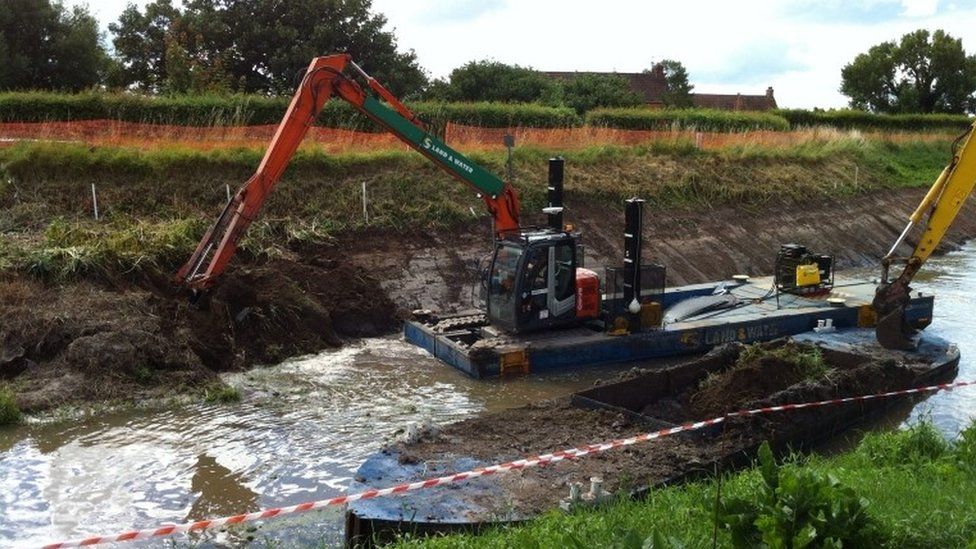Increased Flow Capacity
Dredging can potentially help alleviate flooding woes by improving the flow capacity of rivers, streams, and other water bodies. Here’s how:
- Increased Flow Capacity: Dredging involves removing sediment, debris, and other obstructions from waterways. By doing so, the watercourse’s capacity to convey water is improved. This can reduce the risk of overflowing during periods of heavy rainfall or rapid snowmelt, thus mitigating flooding.
- Restoring Channel Depth: Sediment accumulation can reduce the depth of water channels, leading to decreased flow capacity and increased flood risk. Dredging removes accumulated sediment, restoring the channel’s depth and allowing water to flow more freely. This helps prevent water from backing up and causing flooding during high-flow events.
- Improving Drainage Systems: Dredging can be used to clear out drainage channels, culverts, and stormwater retention ponds. Clearing these pathways enhances their effectiveness in diverting excess water away from populated areas, reducing the likelihood of flooding.
- Enhancing Navigation: In addition to flood mitigation, dredging can also benefit navigation by maintaining sufficient depth for boats and ships to pass through waterways. This can indirectly contribute to flood prevention by ensuring efficient water flow and reducing the risk of blockages.
- Erosion Control: Dredging can address erosion issues by stabilizing banks and shorelines. By removing excess sediment, the natural flow patterns of water can be restored, reducing erosion along riverbanks and preventing further sedimentation downstream.
However, it’s essential to note that while dredging can be an effective tool in flood mitigation, it is not a standalone solution. Integrated flood management approaches, including land use planning, floodplain mapping, green infrastructure development, and other structural and non-structural measures, are necessary to comprehensively address flooding issues in a sustainable manner. Additionally, dredging activities must be carefully planned and executed to minimize potential environmental impacts and ensure long-term effectiveness.
Dredging can offer several benefits in flooding areas, aiding in both flood prevention and management:
- Increased Drainage Capacity: Dredging removes sediment, debris, and vegetation that may obstruct water flow in rivers, streams, and drainage channels. By improving the capacity of these waterways to convey water, dredging helps reduce the risk of localized flooding during heavy rainfall or rapid snowmelt events.
- Flood Risk Reduction: By maintaining adequate channel depths and widths, dredging reduces the likelihood of water overflowing onto adjacent land during periods of high flow. This can help protect homes, businesses, and critical infrastructure from flood damage.
- Improved Flood Response: Dredging can facilitate faster drainage of floodwaters, enabling quicker recovery and reducing the duration of inundation in affected areas. This can minimize the extent of flood damage and the disruption to communities and economies.
- Protection of Infrastructure: Dredging helps prevent sediment accumulation around bridges, culverts, and other infrastructure, reducing the risk of blockages and infrastructure damage during flood events. This ensures the continued functionality and safety of essential transportation networks and utilities.
- Enhanced Navigation: In flood-prone areas with navigable waterways, dredging maintains sufficient depth for boats, barges, and other vessels to navigate safely. This supports commercial shipping, recreational boating, and emergency response activities, even during periods of high water levels.
- Erosion Control: Dredging can stabilize riverbanks and shorelines by removing excess sediment and restoring natural flow patterns. This helps prevent erosion and loss of land in flood-prone areas, preserving valuable habitats, agricultural land, and property.
- Environmental Benefits: Properly managed dredging activities can have positive environmental outcomes, such as restoring habitat diversity, improving water quality through sediment removal, and supporting the health of aquatic ecosystems.
- Long-term Maintenance: Regular dredging maintenance schedules can sustain the effectiveness of flood management infrastructure over time, ensuring continued protection against flooding and minimizing the need for costly emergency response efforts.
While dredging offers significant benefits in flood-prone areas, it’s essential to consider potential environmental impacts and incorporate dredging activities into comprehensive flood management plans that prioritize sustainability and resilience. Additionally, community engagement and stakeholder collaboration are crucial to developing effective dredging strategies that balance flood risk reduction with environmental protection and other societal needs.
